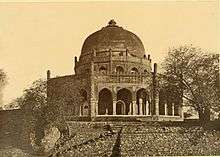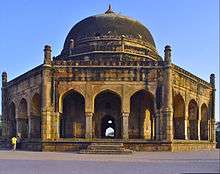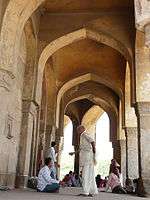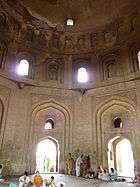Tomb of Adham Khan
Coordinates: 28°31′24.43836″N 77°10′56.13″E / 28.5234551000°N 77.1822583°E


Adham Khan's Tomb (Hindi: आधम खान का मकबरा, Urdu: ادھم خان کا مزار ), (Bangla: আধম খানের সমাধি) the 16th-century tomb of Adham Khan, a general of Mughal Emperor, Akbar. He was the younger son of Maham Anga, Akbar's wet nurse thus also his foster brother. However, when Adham Khan murdered Akbar’s favourite general Ataga Khan in May 1562, Akbar immediately ordered his execution by defenestration from the ramparts of the Agra Fort.
The tomb was built in 1561, and lies to the north of the Qutub Minar, Mehrauli, Delhi, immediately before one reaches the town of Mehrauli,[1] it is now a protected monument by Archaeological Survey of India.[2]
Architecture

It lies on the walls of Lal Kot and rising from a terrace enclosed by an octagonal wall provided with low towers at the corners. It consists of a domed octagonal chamber in the Lodhi Dynasty style and Sayyid dynasty early in the 14th century. It has a verandah on each side pierced by three openings. It is known popularly as Bul-bulaiyan (a Labyrinth or Maze), for a visitor often loses his way amidst the several passages in the thickness of its walls.[3]
History

D.k
Adham Khan, son of Maham Anga, a wet nurse of Akbar, was a nobleman and general in Akbar's army. In 1561, he fell out with Ataga Khan,- Akbar's Prime Minister, and husband of Jiji Anga, another wet nurse, and killed him, whereupon he was thrown down from the ramparts of Agra Fort twice, by the order of the emperor Akbar and died [4]
His mother after fortieth day of mourning also died out of grief, and both were buried in this tomb believed to be commissioned built by Akbar, in a conspicuous octagonal design, not seen in any Mughal building of that era, a designed perhaps designated to the traitors, as it was common design features visible in the tombs of the previous Sur Dynasty, and also the Lodhi dynasty now within the present Lodhi Gardens (Delhi), which the Mughals considered traitors.[5]
In 1830s, a British officer named Blake of Bengal Civil Service, converted this tomb into his residential apartment and removed the graves to make way for his dining hall. Though the officer died soon, it continued to be used as a rest house for many years by the British, and at one point even as a police station and a post office. The tomb was vacated and later restored by the orders of Lord Curzon,[6] and the grave of Adham Khan has since been restored to the site, and lies right below the central dome, though that of his mother Maham Anga never was.[7]
Further reading
- Adham Khan's Tomb The Delhi that No-one Knows, by R.V. Smith. Orient Longman, 2005. ISBN 81-8028-020-9. Page 18.
- Mughals Dictionary of Islamic architecture, by Andrew Petersen. Routledge, 1996. ISBN 0-415-06084-2. Page 203.
- The Cambridge History of India: Mughal Period, by Edward James Rapson. Published by University Press, 1937. Page 532 Tomb of Adham Khan.
- Delhi and Its Neighbourhood, by Y. D. Sharma. Published by Director General, Archaeological Survey of India, 1974. Page 60-61.
- Islamic Tombs in India : The Iconography and Genesis of Their Design, by Fredrick W. Bunce. (Series : Contours of Indian Art and Architecture No. 2. 2004.) ISBN 81-246-0245-X. Chapt. 20.
- Annual York-Noor Lecture Series: “Murder, Mausolea and the Emperor Akbar: Two Early Mughal Tombs” York University
- Mughal Architecture of Delhi : A Study of Mosques and Tombs (1556-1627 A.D.), by Praduman K. Sharma, Sundeep, 2001, ISBN 81-7574-094-9. Chap. 9.
References
- ↑ Adham Khan Tomb archnet.org.
- ↑ List of Monuments - Delhi- Delhi Circle (N.C.T. of Delhi) Archaeological Survey of India.
- ↑ Ashri, Shashi Bhushan (2010). Delhi: A city of cities. Delhi, India: Anubhav Prakashan. p. 38. ISBN 978-93-8005-320-2.
- ↑ What makes a man great? The Tribune, June 9, 2001.
- ↑ Adham Khan's Tomb - Image and History The New Cambridge History of India, by Catherine B. Asher. Cambridge University Press. ISBN 0-521-26728-5. Page 44.
- ↑ Adham Khan's Tomb Delhi, by Patrick Horton, Richard Plunkett, Hugh Finlay. Lonely Planet, 2002. ISBN 1-86450-297-5. Page 127.
- ↑ All About Delhi Delhi, the Capital of India, by Anon. Asian Educational Services, 1997. ISBN 81-206-1282-5.
External links
| Wikimedia Commons has media related to Tomb of Adham Khan. |
- Adam Khan's Tomb
- The Qutub Complex in Delhi - Adham Khan's Tomb
- Images of Adham Khan's Tomb Indira Gandhi National Centre for the Arts (IGNCA)
- Adham Khan's Tomb wikimapia.
- The tomb of Adham Khan near the Qutb Minar in Sir Thomas Metcalfe's Diary, 1843 British Library